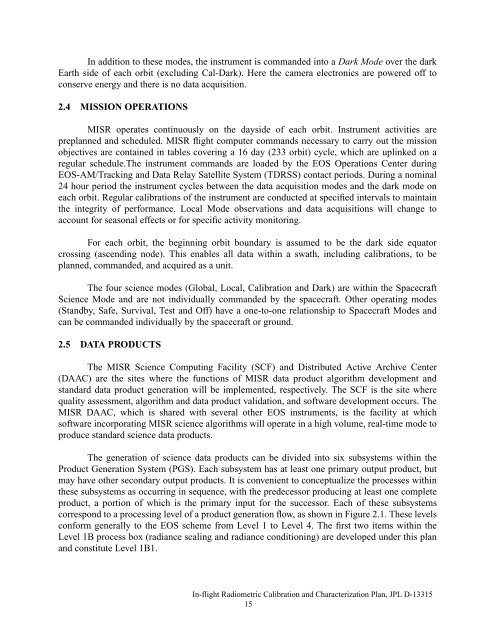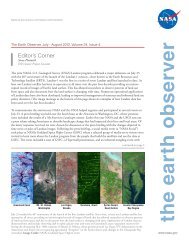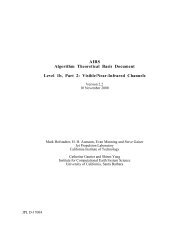MISR: In-Flight Radiometric Calibration and Characterization Plan
MISR: In-Flight Radiometric Calibration and Characterization Plan
MISR: In-Flight Radiometric Calibration and Characterization Plan
You also want an ePaper? Increase the reach of your titles
YUMPU automatically turns print PDFs into web optimized ePapers that Google loves.
<strong>In</strong> addition to these modes, the instrument is comm<strong>and</strong>ed into a Dark Mode over the darkEarth side of each orbit (excluding Cal-Dark). Here the camera electronics are powered off toconserve energy <strong>and</strong> there is no data acquisition.2.4 MISSION OPERATIONS<strong>MISR</strong> operates continuously on the dayside of each orbit. <strong>In</strong>strument activities arepreplanned <strong>and</strong> scheduled. <strong>MISR</strong> flight computer comm<strong>and</strong>s necessary to carry out the missionobjectives are contained in tables covering a 16 day (233 orbit) cycle, which are uplinked on aregular schedule.The instrument comm<strong>and</strong>s are loaded by the EOS Operations Center duringEOS-AM/Tracking <strong>and</strong> Data Relay Satellite System (TDRSS) contact periods. During a nominal24 hour period the instrument cycles between the data acquisition modes <strong>and</strong> the dark mode oneach orbit. Regular calibrations of the instrument are conducted at specified intervals to maintainthe integrity of performance. Local Mode observations <strong>and</strong> data acquisitions will change toaccount for seasonal effects or for specific activity monitoring.For each orbit, the beginning orbit boundary is assumed to be the dark side equatorcrossing (ascending node). This enables all data within a swath, including calibrations, to beplanned, comm<strong>and</strong>ed, <strong>and</strong> acquired as a unit.The four science modes (Global, Local, <strong>Calibration</strong> <strong>and</strong> Dark) are within the SpacecraftScience Mode <strong>and</strong> are not individually comm<strong>and</strong>ed by the spacecraft. Other operating modes(St<strong>and</strong>by, Safe, Survival, Test <strong>and</strong> Off) have a one-to-one relationship to Spacecraft Modes <strong>and</strong>can be comm<strong>and</strong>ed individually by the spacecraft or ground.2.5 DATA PRODUCTSThe <strong>MISR</strong> Science Computing Facility (SCF) <strong>and</strong> Distributed Active Archive Center(DAAC) are the sites where the functions of <strong>MISR</strong> data product algorithm development <strong>and</strong>st<strong>and</strong>ard data product generation will be implemented, respectively. The SCF is the site wherequality assessment, algorithm <strong>and</strong> data product validation, <strong>and</strong> software development occurs. The<strong>MISR</strong> DAAC, which is shared with several other EOS instruments, is the facility at whichsoftware incorporating <strong>MISR</strong> science algorithms will operate in a high volume, real-time mode toproduce st<strong>and</strong>ard science data products.The generation of science data products can be divided into six subsystems within theProduct Generation System (PGS). Each subsystem has at least one primary output product, butmay have other secondary output products. It is convenient to conceptualize the processes withinthese subsystems as occurring in sequence, with the predecessor producing at least one completeproduct, a portion of which is the primary input for the successor. Each of these subsystemscorrespond to a processing level of a product generation flow, as shown in Figure 2.1. These levelsconform generally to the EOS scheme from Level 1 to Level 4. The first two items within theLevel 1B process box (radiance scaling <strong>and</strong> radiance conditioning) are developed under this plan<strong>and</strong> constitute Level 1B1.<strong>In</strong>-flight <strong>Radiometric</strong> <strong>Calibration</strong> <strong>and</strong> <strong>Characterization</strong> <strong>Plan</strong>, JPL D-1331515







